The air force’s main combat aircraft, including F16 and Mirage jets, practiced emergency takeoffs and landings on sections of a freeway in the south yesterday as part of the military’s annual Han Kuang series of exercises that began on Monday.
An F-16 fighter jet, a Mirage 2000-5 and an Indigenous Defense Fighter (IDF) were used in the drill, landing shortly after 7am on the Minxiong (民雄) section of the Sun Yat-sen Freeway (National Freeway No. 1) in Chiayi County.
It was the first time the air force had one of its E-2K airborne early warning aircraft take part in the freeway practices.
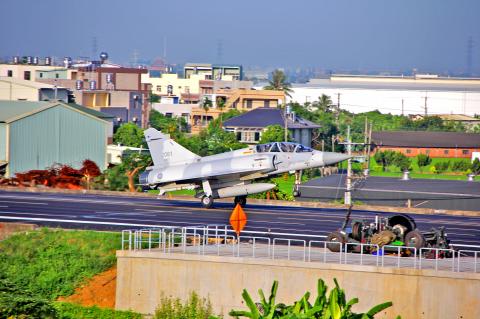
Photo: Lin I-chang, Taipei Times
The E-2K, an all-weather early warning and control system platform equipped with radar and surveillance systems, has an extremely large wingspan which covers nearly the width of the freeway.
The E-2K pilot landed smoothly, gliding to the end of the temporary runway while folding up the craft’s large wings and moving to the designated area for resupply.
Other aircraft taking part in the drill included a CH-47 Chinook helicopter, an OH-58D reconnaissance helicopter and two AH-1W Super Cobra attack helicopters.
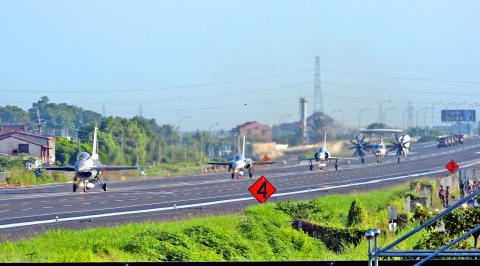
Photo: CNA
Yesterday’s exercise was to simulate an attack from China that destroys the air force base runways, requiring the military to rely on freeways as makeshift airstrips, an air force official said.
The Minxiong section is one of four sections of the nation’s main north-south freeway designated as emergency runways in the event of war.
The drill began with an F-16 landing on the freeway, followed by the IDF, the Mirage 2000-5 and the E-2K. Ground crews reloaded the aircraft’s ammunition bays and refueled the jets before they took off.
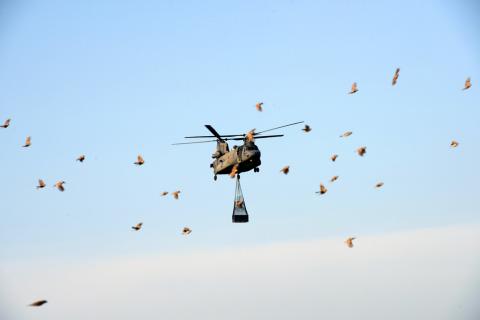
Photo: AFP
The F-16 was loaded with AIM-120 advanced medium-range air-to-air missiles, while the IDF and the Mirage fighter were loaded with AIM-9P4 Sidewinder missiles and MICA air-to-air missiles respectively, the air force said.
The twin-engine CH-47 Chinook, which was escorted by AH-1W Super Cobra helicopters, was used to deliver supplies.
Chief of General Staff Admiral Kao Kuang-chi (高廣圻) oversaw the exercise.
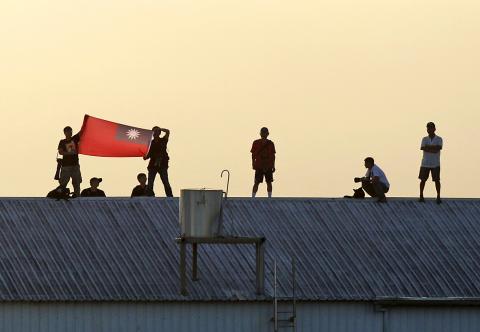
Photo: Reuters
The military coordinated with transportation agencies on the maintenance of the roadway before the drill, including repaving it to make sure it was flat, and familiarizing ground crews and pilots with the freeway, he said.
Colonel Shih Sheng-te (施勝德) of the air force’s 455th Tactical Fighter Wing said the Minxiong site presents pilots with several difficulties.
“Preparations were made beforehand to avoid bird collisions and intrusion of other objects. The area is also complicated by the presence of T-bars, power transmission towers and electricity grid lines. The Minxiong section is the most difficult among all the nation’s freeway emergency landing sections,” he said.
Another feature of yesterday’s drill was the use civilian aircraft to transport military personnel taking part in the exercises. Far Eastern Air Transport (遠東航空) and TransAsia Airways (復興航空), together with military C-130 planes, ferried one battalion of soldiers from an airport in Greater Kaohsiung to an air base in Penghu.
Meanwhile, two civilians trying to take photographs of the drill were injured after falling off a ladder as a CH-47 Chinook helicopter was delivering supplies for the fighter jets.
The strong vortex winds generated by the chopper’s rotors made it difficult for the pair to keep their balance, said Lieutenant General Wang Hsuan-chou (汪旋周), director-general of the air force’s Political Warfare Department.
“One man sustained an injury to his jaw and was discharged from Chiayi Christian Hospital after treatment, while the other man fractured his hand,” Wang said.
Yesterday’s drill was part of the second stage of the “Han Kuang 30” exercises, which are to run through Friday.

A Chinese aircraft carrier group entered Japan’s economic waters over the weekend, before exiting to conduct drills involving fighter jets, the Japanese Ministry of Defense said yesterday. The Liaoning aircraft carrier, two missile destroyers and one fast combat supply ship sailed about 300km southwest of Japan’s easternmost island of Minamitori on Saturday, a ministry statement said. It was the first time a Chinese aircraft carrier had entered that part of Japan’s exclusive economic zone (EEZ), a ministry spokesman said. “We think the Chinese military is trying to improve its operational capability and ability to conduct operations in distant areas,” the spokesman said. China’s growing
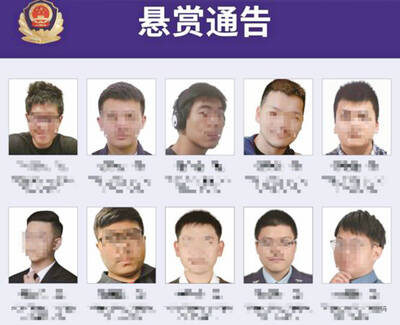
Taiwan yesterday denied Chinese allegations that its military was behind a cyberattack on a technology company in Guangzhou, after city authorities issued warrants for 20 suspects. The Guangzhou Municipal Public Security Bureau earlier yesterday issued warrants for 20 people it identified as members of the Information, Communications and Electronic Force Command (ICEFCOM). The bureau alleged they were behind a May 20 cyberattack targeting the backend system of a self-service facility at the company. “ICEFCOM, under Taiwan’s ruling Democratic Progressive Party, directed the illegal attack,” the warrant says. The bureau placed a bounty of 10,000 yuan (US$1,392) on each of the 20 people named in
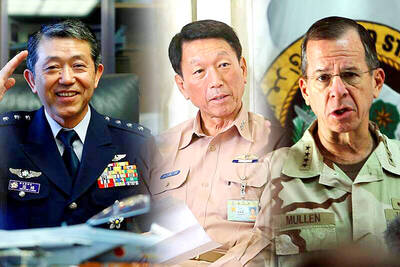
Nine retired generals from Taiwan, Japan and the US have been invited to participate in a tabletop exercise hosted by the Taipei School of Economics and Political Science Foundation tomorrow and Wednesday that simulates a potential Chinese invasion of Taiwan in 2030, the foundation said yesterday. The five retired Taiwanese generals would include retired admiral Lee Hsi-min (李喜明), joined by retired US Navy admiral Michael Mullen and former chief of staff of the Japan Self-Defense Forces general Shigeru Iwasaki, it said. The simulation aims to offer strategic insights into regional security and peace in the Taiwan Strait, it added. Foundation chair Huang Huang-hsiung
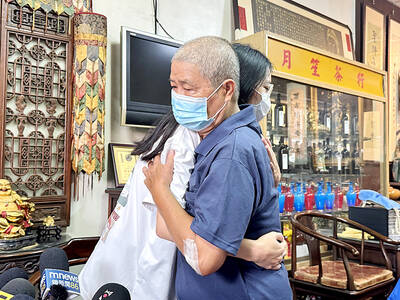
PUBLIC WARNING: The two students had been tricked into going to Hong Kong for a ‘high-paying’ job, which sent them to a scam center in Cambodia Police warned the public not to trust job advertisements touting high pay abroad following the return of two college students over the weekend who had been trafficked and forced to work at a cyberscam center in Cambodia. The two victims, surnamed Lee (李), 18, and Lin (林), 19, were interviewed by police after landing in Taiwan on Saturday. Taichung’s Chingshui Police Precinct said in a statement yesterday that the two students are good friends, and Lin had suspended her studies after seeing the ad promising good pay to work in Hong Kong. Lee’s grandfather on Thursday reported to police that Lee had sent